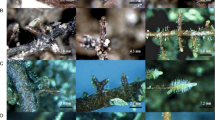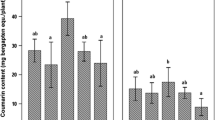Abstract
Growth and enzymatic activities of extraradical mycelia (ERM) of native mycorrhizal symbionts associated with three orchid species, Dactylorhiza fuchsii, D. majalis and Platanthera bifolia, were studied. ERM extracted from the mycorrhizosphere of these species showed features typical for fungi that form orchid mycorrhiza. In the first pot experiment, three different treatments were applied on tubers of D. fuchsii transplanted from a natural site: control (no specific treatment), reinoculated (surface-sterilized tubers reinoculated with mycorrhizal fungi-colonised roots), and benomyl (nonsterilized tubers treated with fungicide). However, no significant differences in ERM growth and intensity of root mycorrhizal colonisation at harvest were observed among these treatments. ERM associated with reinoculated D. fuchsii plants showed significantly higher alkaline phosphatase (ALP) enzymatic activity at week 36 than at week 24, but no differences were observed for NADH diaphorase activity. Benomyl application significantly reduced ALP activity in comparison with reinoculated plants at week 36. In the second experiment, plants of all three species were either untreated (control), or repeatedly treated with benomyl. Similarly to the results of the first experiment, benomyl application did not reduce the ERM growth of mycorrhizal symbionts associated with D. majalis and D. fuchsii. The low ERM growth associated with benomyl-treated P. bifolia was probably caused by poor root system development in this treatment. Significantly higher mycorrhizal colonisation was found for D. fuchsii compared to P. bifolia in control treatments at the end of cultivation. The ERM of native symbionts of the three orchid species studied seemed to have a different growth pattern over time and responded differently to fungicide application.
Similar content being viewed by others

Abbreviations
- ALP:
-
alkaline phosphatase
- CITES:
-
Convention on International Trade in Endangered Species of Wild Fauna and Flora
- ERM:
-
extraradical mycelium
- INT:
-
iodonitrotetrazolium chloride
- NADH:
-
reduced form of nicotinamide adenine dinucleotide
- OM:
-
orchid mycorrhiza
- SE:
-
standard error
References
Alexander C. & Hadley G. 1984. The effect of mycorrhizal infection of Goodyera repens and its control by fungicide. New Phytol. 97: 391–400.
Alexander C. & Hadley G. 1985. Carbon movement between host and mycorrhizal endophyte during the development of the orchid Goodyera repens Br. New Phytol. 101: 657–665.
Andersen T.F. 1996. A comparative taxonomic study of Rhizoctonia sensu lato employing morphological, ultrastructural and molecular methods. Mycol. Res. 100: 1117–1128.
Baláž M. & Vosátka M. 2001. A novel inserted membrane technique for studies of mycorrhizal extraradical mycelium. Mycorrhiza 11: 291–296.
Bayman P., Gonzáles E.J., Fumero J.J. & Tremblay R.L. 2002. Are fungi necessary? How fungicides affect growth and survival of the orchid Lephantes rupestris in the field. J. Ecol. 90: 1002–1008.
Beau C. 1913. Sur les rapports entrée la tuberisation et l’infestation des racines par des champignons endophytes au cours de développement du Spiranthes autumnalis. Compte Rendu Hebdomadaire des Séances de l’Académie des Sciences Paris 157: 512–515.
Bernard N. 1909. L’evolution dans la symbiose des orchideés et leur champignons commensaux. Annalles des Sciences Naturalles, Paris, 9. ser. 14: 1–196.
Bidartondo M.I, Burghardt B., Gebauer G., Bruns T.D. & Read D.J. 2004. Changing partners in the dark: isotopic and molecular evidence of ectomycorrhizal liaisons between forest orchids and trees. Proc. Royal Soc. London Series B 271: 1799–1806.
Boosalis M.G. & Scharen A.L. 1959. Methods for microscopic detection of Abhanomyces euteiches and Rhizoctonia solani associated with plant debris. Phytopathol. 49: 192–198.
Burgeff H. 1909. Die Wurzelpilze der Orchideen, ihre Kultur und ihre Lebemn in der Pflanze. Gustav Fischer, Jena.
Burgeff H. 1936. Samenkeimung der Orchideen. Gustav Fischer, Jena.
Cullings K.W., Szaro T.M. & Bruns T.D. 1996. Evolution of extreme specialization within a lineage of ectomycorrhizal epiparasites. Nature 379: 63–66.
Currah R.S., Sigler L. & Hambleton S. 1987. New records and taxa of fungi from the mycorrhizae of terrestrial orchids of Alberta. Can. J. Bot. 65:2473–2482.
Currah R.S., Smreciu E.A. & Hambleton S. 1990. Mycorrhizae and mycorrhizal fungi of boreal species of Platanthera and Coeloglossum (Orchidaceae). Can. J. Bot. 68: 1171–1181.
Currah R.S., Zelmer C.D., Hambleton S. & Richardson K.A. 1997. Fungi from orchid mycorrhizas, pp. 117–170. In: Arditti J. & Pridgeon A.M. (eds), Orchid Biology: Review and Perspectives, VII. Kluwer Academic Publications, Dordrecht.
Fitter A.H. & Nichols R. 1988. The use of benomyl to control infection by vesicular-arbuscular mycorrhizal fungi. New Phytol. 110: 201–206.
Fuchs A. & Ziegenspeck H. 1927. Entwicklung, Axen und Blätter einheimischer Orchideen, IV. Botanisches Archive 20: 275–422.
Gardes M. & Bruns T.D. 1993. IST primers with enhanced specifity for basidiomycetes — application to the identification of mycorrhizae and rusts. Molec. Ecol. 2: 113–118.
Hadley G. 1984. Uptake of [14C] glucose by asymbiotic and mycorrhizal orchid protocorms. New Phytol. 96: 263–273.
Harnett D.C. & Wilson G.T. 1998. Mycorrhizae influence plant community structure and diversity in tallgrass prairie. Ecology: 1187–1195.
Holub J. & Procházka F. 2000. Red list of vascular plants of the Czech Republic. Preslia 72: 187–230.
Jabaji-Hare S.H. & Kendrick W.B.1987. Response of an endomycorrhizal fungus in Allium porrum L. to different concentrations of the systemic fungicides, Metalaxyl (Ridomil) and Fosetal-al (Aliette). Soil Biol. Biochem. 19: 95–99.
Jurčák J. 2003. Mycorrhizal conditions and anatomical study of underground organs of chosen species from the family Orchidaceae. Assoc. Prof. Thesis, Palacký University, Olomouc. (In Czech)
Kahiluoto H., Ketoja E. & Vestberg M. 2000a. Creation of a non-mycorrhizal control for a bioassay of AM effectiveness, 1. Comparison of methods. Mycorrhiza 9: 241–258.
Kahiluoto H., Ketoja E. & Vestberg M. 2000b. Creation of a non-mycorrhizal control for a bioassay of AM effectiveness, 2. Benomyl application and soil sampling time. Mycorrhiza 9: 259–270.
Kjøller R. & Rosendahl S. 2000. Detection of arbuscular mycorrhizal fungi (Glomales) in roots by nested PCR and SSCP (single strand conformation polymorphism). Plant Soil 226: 189–196.
Kristiansen K.A., Taylor D. L., Kjøller R., Rasmussen H.N. & Rosedahl S. 2001. Identification of mycorrhizal fungi from single pelotons of D. majalis (Orchidaceae) using single strand conformation polymorphism and mitochondrial ribosomal large subunit DNA sequences. Molec. Ecol. 10: 2089–2093.
Látalová K., Knotová, K. & Baláž M. 2003 The effects of fungicides on extraradical mycelium of orchid mycorrhiza, pp. 154–157. In: Plant Physiology Conference of Ph.D. Students and Young Scientists; Book of Abstracts, Brno, Mendel University of Agriculture and Forestry, Faculty of Agronomy and Masaryk University, Faculty of Science.
Látr A., Čuříková M., Baláž M. & Jurčák J. 2008. Mycorrhizas of Cephalanthera longifolia and Dactylorhiza majalis, two terrestrial orchids. Ann. Bot. Fen. 45: 281–289.
Manninen A.M., Laatikainen T. & Holopainen T. 1998. Condition of Scots pine fine roots and mycorrhiza after fungicide application and low-level exposure in a 2-year field experiment. Trees 12: 347–355.
Menge J.A. 1982. Effect of soil fumigants and fungicides on vesicular-arbuscular fungi. Phytopathol. 72: 1125–1132.
Merryweather J. & Fitter A. 1996. Phosphorus nutrition of an obligately mycorrhizal plant treated with the fungicide benomyl in the field. New Phytol. 132: 307–311.
Mitchell R.B. 1989. Growing hardy orchids from seeds at Kew. The Plantsman 11: 152–169.
Němec S. 1980. Effects of 11 fungicides on endomycorrhizal development in sour orange. Can. J. Bot. 58: 522–526.
O’Connor P. J., Smith S.E. & Smith E.A. 2002. Arbuscular mycorrhizas influence plant diversity and community structure in semi-arid herbland. New Phytol. 154: 209–218.
Phillips J. M. & Hayman D.S. 1970. Improved procedures for cleaning roots and staining parasitic and vesicular-arbuscular mycorrhizal fungi for rapid assessment of infection. Trans. British Mycol. Soc. 55: 158–161.
Rasmussen H. 2002. Recent developments in the study of orchid mycorrhiza. Plant Soil 244: 149–163.
Rasmussen H. & Whigham D. 2002. Phenology of roots and mycorrhiza in five orchid species differing in phototrophic strategy. New Phytol. 154: 797–807.
Selosse M.A., Faccio A., Scappaticci G. & Bonfante P. 2004: Chlorophyllous and Achlorophyllous Specimens of Epipactis microphylla (Neottieae, Orchidaceae) Are Associated with Ectomycorrhizal Septomycetes, including Truffles. Microb. Ecol. 47: 416–426.
Smith S.E. 1966. Physiology and ecology of orchid mycorrhizal fungi with reference to seedling nutrition. New Phytol. 65: 488–499.
Sylvia D.M. 1988. Activity of external hyphae of vesiculararbuscular mycorrhizal fungi. Soil Biol. Biochem. 20: 39–43.
Teste F., Karst J., Jones M., Simard S. & Durall D. 2006. Method to control ectomycorhizal colonization: effectivness of chemical and physical barriers. Mycorrhiza 17: 51–65.
Tisserant B., Gianinazzi-Pearson V., Gianinazzi S. & Gollotee A. 1993. In planta histochemical staining of fungal alkaline phosphatase activity for analysis of efficient arbuscular mycorrhizal infections. Mycol. Res. 97: 245–250.
Trappe J.M., Molina R. & Castellano M. 1984. Reaction of mycorrhizal fungi and mycorrhizal formation to pesticides. Ann. Rev. Phytopatol. 22: 331–359.
Tu C.C. & Kimbrough J.W. 1975. Morphology, development and cytochemistry of the hyphae and sclerotia of species in the Rhizoctonia complex. Can. J. Bot. 53: 2282–2296.
Warcup J.H. & Talbot P.H.B. 1967. Perfect states of Rhizoctonias associated with orchids. New Phytol. 66: 631–641.
Warcup J.H. 1981. The mycorrhizal relationship of Australian orchids. New Phytol. 87: 371–381.
Wilson G.W.T., Hartnett D.C., Smith M.D. & Kobbeman K. 2001. Effects of mycorrhizae on growth and demography of tallgrass praire forbs. Amer. J. Bot. 88: 1452–1457.
Yoder J.A., Zettler L.W. & Stewart L.S. 2000. Water requirements of terrestrial and endophytic orchid seeds and seedlings and evidence for water uptake by means of mycotrophy. Plant Sci. 156: 145–150.
Author information
Authors and Affiliations
Corresponding author
Rights and permissions
About this article
Cite this article
Čuříková, M., Látr, A. & Vosátka, M. Growth and viability of mycorrhizal extraradical mycelia associated with three temperate orchid species. Biologia 64, 63–68 (2009). https://doi.org/10.2478/s11756-009-0001-2
Received:
Accepted:
Published:
Issue Date:
DOI: https://doi.org/10.2478/s11756-009-0001-2



